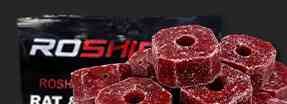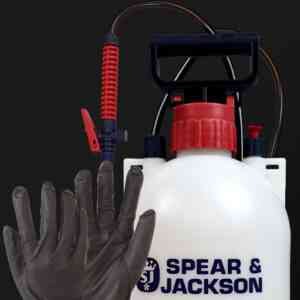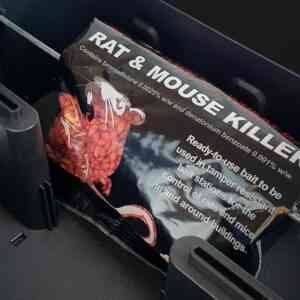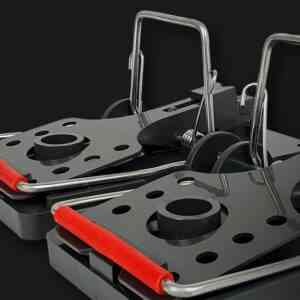We fully appreciate that choosing the correct method of rodent control can be challenging, especially as we have several options available, we hope the following information, broken down into simple sections, will help amateur DIY users understand the best approach for control
Table of Contents
Identify the rodent species.
The first step in any treatment is too always identify the target species, do you have mice, rats or squirrels? Treatments will vary on the product so the target species must be correctly identified. Identification when physically seeing the rodent is generally straight-forward, its when you only see signs such as droppings or chew marks does it make this step more difficult. The below details provides some basic information:
- Rats are normally found in gardens and outbuildings but can often make nests within properties. Generally rats have large droppings the size and shape of a cashew nut. Rats do not always leave droppings in the open so it’s often down to other signs such as disappearing foods or large quantities of packaging damaged. Rats are nocturnal and principle active at night only; except for when the infestation is developed. Rats are often heard in cavities of walls and in the attic space, at night they can be rather loud. We have several control methods suitable for rats.
- Mice often leave significantly more signs of their activity, including droppings found within and around their infestation area. Mice droppings can range in size, usually the size and look of a grain of rice, some droppings can be significantly smaller. Mouse infestations are typically found in buildings, especially within attic spaces and kitchens. Mice can often be heard at night, especially within attics, and their noise can often be associated with rats. We have several control methods suitable for mice.
- Squirrels are not as common as rats and mice but can still be a significant nuisance within attic spaces. Generally, squirrels will only access a building through fascias and soffits, they don’t seem to like to stray too far away from their dray; if noise is heard within cavities or in lower sections of a house the likelihood is that squirrels are not too blame! We do not currently have a control method for squirrels but we do sell several products that are suitable for their proofing
Identify the location and size of the infestation
Finding out the location and understanding how established they are is likely one of the essential steps when treating rodents. As a previous pest controller, one of the most common phrases I heard from customers was “It’s just the one!”; sadly this is not the case the moment you see a rodent active within a building the likelihood is the infestation is more significant than you may think. A common mistake when treating rodents is under baiting or not putting enough control devices down; this can often lead to more critical issues further down the treatment path including bait avoidance and shyness.
Before selecting a control method understanding where the primary source of the infestation will help you choose the right product, Whilst you may see rodents active in your lounge or bathroom this isn’t a great place to control them; treatment is always best reserved for voids and areas away from human habitation. For example, placing a trap under a kitchen cupboard, behind the plinth, is significantly more likely to work than placement within the open, where rodents are more alert and cautious of their environment.
Common locations often associated with rodents within and around buildings:
- Sheds / Garages / Greenhouses – Normally rodents are found under the foundations or directly accessing the buildings through easily accessible holes. Once inside they often use leaves and loose debris as nesting materials and love a cardboard box!
- Attic spaces / Dormer Cupboards / Airing Cupboards – Rodents love these warm areas within buildings and are commonly found nesting in the insulation, especially within attics; this is often overlooked.
- Kitchens / Boot Rooms – Rodents are often found at the back of cupboards, especially ones with pipe access, such as under the sink. Rats and mice often frequent the voids under the cupboard below the kickboards/plinths.
- Cavities, Under Flooring & Other voids – Rats and mice love following pipes and these often lead around the house, including under flooring and the cavities. Both rats and mice are usually found in this area, and treatment devices may be more restricted so if no access can be found and you are not willing to remove floorboards, focus control on the attic or kitchen.
- Bird Feeders / Compost Heaps / Chicken Pens – Rats are one of the most significant pests in external environments. A wide range of reasons, especially the location and available food sources, can help factor the size of the infestation. Removal of available food sources as well as using a tamper-resistant bait station for both rodenticides and traps are vital in these areas
Select a control method
We usually have two main methods of control for rodents: rodenticide or traps. Both control methods are excellent and proven methods of rodent control and regardless of which option you choose the end result will likely lead to their control. One of the main risks involved when dealing with rodents is the risk to non-target animals, this is mainly an issue with rodenticide, and extreme caution should always be undertaken. Proofing of the rodents is an alternative control method, but only recommended in limited scenarios.
- Traps are a great way to control rodents safely, they are an established and trusted solution and will often result in the fast removal of rodents from a treatment area. They are quick and offer a fast and humane death. The correct device must be selected for the correct species. While traps are great for small and emerging infestations, they can be time-consuming as users need to regularly check and maintain the traps and closely handle rodent bodies.
- Rodenticide (Rat & Mouse Poison) is a well-proven control for rats and mice (not squirrels), the process can be more simple and less time-consuming compared to traps. Rodenticide can however come with several issues that make treatments complicated, primarily using the product in the correct location and making sure that non-target animals cannot gain access to the product; users must follow the instruction on the packaging supplied with the product. A significant issue with rodenticide is a growing issue of resistance.
- Proofing is the application of a physical barrier to prevent rodents, this can be a sufficient option however does come with risks, primarily blocking the exit of the rodent from leaving a property. For best results using traps or rodenticide as a first step is recommended before application of prevention materials.
If you select Rodenticide, what formulation and active ingredient do you buy
In the UK we have three standard formulations available, blocks, wheat and pasta; their is no right selection and a hungry rodent will eat any of these. Blocks are more weather-resistant so they are suitable for external environments or when baiting within damp locations, pasta is a more calorific choice and great for when competing again uncontrolled food sources, especially within towns. Wheat is a great all-rounder and often the most accepted out of the choices of rodenticides and often the most used of the rodenticides; spillage can be an issue with wheat so its best used in controlled environments and locked boxes that are attached to walls.
- For rats, we recommend wax blocks for when baiting outside around buildings and wheat for internal baiting.
- For mice, we recommend wheat or pasta as the initial choices and blocks for when baiting in sensitive areas, simply as the spillage is reduced.
Selecting the active ingredient can be slightly more confusing. In the UK we have three main types of elements, difenacoum, bromadiolone and brodifacoum, whilst all are similar they have their differences.
- Difenacoum is a second-generation rodenticide (also called a super-warfarin), a high-strength rodenticide approved for rats and mice. Difenacoum works better for mice and it is considerably safer to use around non-target animals, especially pets, but caution should still be taken. This is a multi-feed bait, so rats and mice will need to feed multiple times for the rodenticide to be effective. Both rats and mice are showing signs of resistance within specific areas; especially around Reading, Bolton, Kent areas.
- Bromadiolone is a second-generation similar to difenacoum and approved for rats and mice. Bromadiolone works better for rats but is also very effective against mice. Again this is a multi-feed bait and multiple feeds are required. Baiting around non-target animals should be undertaken with caution. Again resistance is a growing issue with this bait so you must check if you are in a resistance area.
- Brodifacoum is similar to the above baits but is more toxic and rodents have not developed any resistance, so its great to be used within areas of known resistance. Brodifacoum is a single-feed so they only need to consume a small amount once to succumb to the effects of the rodenticide. This bait should be used only when the other active ingredients have not been effective, brodifacoum can be highly toxic to non-target animals so its use should be managed and used with caution.
From the three above active ingredients, it’s important to note that brodifacoum unless used within an area of known resistance, should be used as the final resort. Its also good to note that brodifacoum is no quicker in controlling an infestation. Using this as the initial bait may cause complications, especially if under-baiting. We recommend that all users should initially start with bromadiolone of difenacoum as the likelihood is that these baits will control the infestation, only resort to brodifacoum when these fail.
We like to stress at Roshield the importance of reading the instructions on the packaging, this is a legal requirement and should be followed at all times. We do provide additional instructions to complement any treatment. The main priority when using rodenticide is using a tamper-resistant bait station. With all rodenticides, especially brodifacoum, inspecting the site regularly and quickly removing dead rodents is part of a rodent treatment, intending to prevent the rodenticide from being passed through the food chain.
Purchase the correct quantity
This is now where it can be difficult to estimate as all infestations will vary in a wide range of factors including the population size and the local environment. It is not uncommon, especially for rodenticide, to under-estimate the size of an infestation; under-baiting an issue can cause a lot of long-term issues including future bait shyness as well as resistance – so it’s important that once treatment has started it is followed through until eradication has been successful.
- Traps for Mice – We recommend a minimum of 6 mouse traps, spaced throughout the infestation area; larger infestations should require additional traps.
- Traps for Rats – We recommend a minimum of 2 traps within the area of infestation, using additional traps up to 6 will likely result in a better capture rate – you do however not want to overcrowd the area with too many traps – so spacing them out is recommended
- Rodenticide for Mice – Again depending on the size of the infestation, larger populations will require additional bait, we would recommend 150-300g pasta or wheat bait and between 5-10 mouse boxes.
- Rodenticide for Rats – Rats can consume a much larger amount of poison bait, for a starter, we would recommend around a 1kg of bait; again large infestations will quickly require additional amounts of bait.
Under-baiting is an issue that can be a significant factor in rodenticide control and its associated failure, as previously mentioned it can lead to a range of issues including bait shyness. If you choose this option, you must commit to baiting sufficiently until no more activity is present.
Follow the instructions
Fairly easy this section but it’s important to follow the instructions on the packaging, especially when using rodenticide.
For both traps and rodenticides, we provide a range of comprehensive instructions to help guide the use of products. These are always included within the packaging.
Commit to the treatment
Once the control device has been placed within the area of infestation it is essential to carry on with the treatment.
Traps and poison should be checked regularly and at a minimum daily. We should note that rats and mice are always cautious of new items within their territory, it’s called neophobia which means being scared of anything new; this can be a major issue when treating rodents and often traps and bait will be ignored for the first 2-3 days, sometimes a week, it’s certainly not a sign a defect within the control method. If traps or bait are taken immediately it’s a good sign that the infestation is more significant than you first may have thought! (i.e. competing for food within the population)
If using rodenticide, check regularly and replenish the bait as necessary. For baits that are consumed quickly, you may want to increase the number of feed points.
For traps it’s not uncommon for rodents to remove bait from the trap without setting off the mechanism; persistence is the key here as the rodent will sooner or later make a mistake and trigger the treadle plate. It’s important that the bodies are removed promptly and disposed of correctly; it is bad to leave a body to decay on the trap as this can send a signal to other rodents to keep away!
Post-treatment
Once no further activity persists you must assume that the infestation is no longer active; removing the control devices to prevent harm to other animals is essential.
Rodenticide should be stored within a safe environment away from children and animals. Shelf life will vary depending on the product, usually within 1 or 2 years.
Traps can be left insitu but they should not be set. For best practice, they should also be stored in a location away from children and animals.
Tamper-resistant bait stations are best left in position, should an infestation occur again then the boxes will already be part of a rodent’s territory and any control device will be accepted quicker (i.e. avoiding the earlier mentioned neophobia behaviour).
Prevention
One of the essential aspects of any treatment is to take all steps as possible to prevent re-infestation. It’s critical that holes and any access points are sealed to avoid access. This is not always an easy task, especially for mice, but proofing significantly reduces the likelihood that mice will renter a property – but does not entirely remove the risk.
Some necessary proofing steps include:
- Drain guards: Rodent flaps within the drainage system allow waste to flow freely away from the property but prevent access to the internal chambers by rodents. This device only works against rats. It is a common access point when rats are in buildings, especially if no obvious holes exist.
- Vent Covers: These covers are designed to be installed over air brick covers, once installed they allow for air movement whilst still preventing access. We have two types of vent covers. Our plastic frame with stainless steel mesh is excellent for stopping many pests including rats, mice and insects. Our aluminium metal vent covers are great for use in areas of heavy pressure and active infestations including for rats and squirrels.
- Rodent Mesh: We have a range of mesh available to physically prevent rodents from gaining access to a void or open area. Mesh is easy to install and can be used for larger holes than our vent covers or for compacting into small holes to act as a permanent barrier.
- Rodent Proofing Paste: A product unique to Roshield, our proofing paste is an excellent solution for proofing small holes quickly and fast, the internal paste never sets and once chewed by a rodent will quickly deter their actions.
Cleaning
Rodents are known to carry a wide range of diseases, primarily through their urine, which is spread throughout the rodent’s territory on surfaces, pipework and voids. Whilst general household chemicals suffice for the majority of cleaning actions it’s often the case that these treatments will not always be appropriate.
At Roshield we recommend that droppings and surfaces with a history of rodent activity are treated to remove the associated bacteria and viruses, we have a range of surface sprays suitable for treating large areas, such as our anti-bacterial sprays.
Popular Products:
-
Sale!
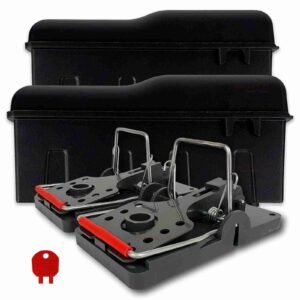
2X Roshield Internal Rat Trap Box Kit
£25.49Original price was: £25.49.£21.49Current price is: £21.49. inc. VAT View Product -
Sale!

2X Roshield Baiter with Rat Trap Kit
£31.99Original price was: £31.99.£27.49Current price is: £27.49. inc. VAT View Product -
Sale!

4X Roshield Baiter Tamper-Resistant Bait Station Box
£36.99Original price was: £36.99.£34.99Current price is: £34.99. inc. VAT View Product -
Sale!

2X Roshield Baiter Tamper-Resistant Bait Station Box
£29.99Original price was: £29.99.£24.99Current price is: £24.99. inc. VAT View Product -
Sale!

2X Black Cat Large Rat Trap
£36.99Original price was: £36.99.£31.99Current price is: £31.99. inc. VAT View Product -
Sale!

Roshield Pasta Bait Sachets 150 grams
£8.99 – £25.99 inc. VAT View Product -
Sale!

Roshield Whole Wheat Sachets 150 grams
£7.99 – £29.99 inc. VAT View Product -
Sale!
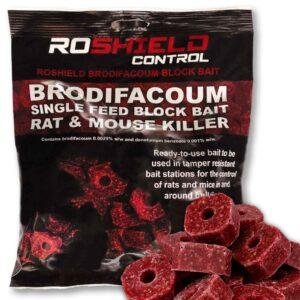
Roshield Single-Feed Bait Blocks 300 grams
£10.99 – £35.99 inc. VAT View Product -
Sale!
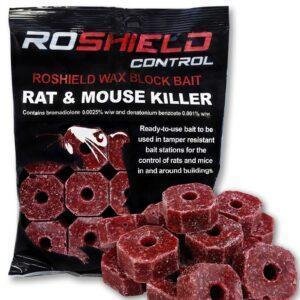
Roshield Wax Bait Blocks 300 grams
£9.99 – £54.99 inc. VAT View Product -
Sale!
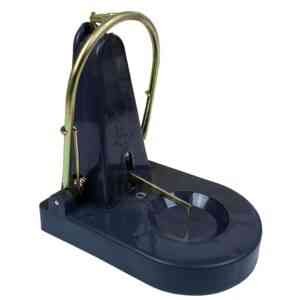
Black Cat Large Rat Trap
£24.99Original price was: £24.99.£19.99Current price is: £19.99. inc. VAT View Product -

Roshield Sanitiser & Cleaner RTU Spray 1Ltr
£17.99 inc. VAT View Product -
Sale!

Roshield Stainless Rat Flap Drain Guard
£65.99 – £97.99 inc. VAT View Product -
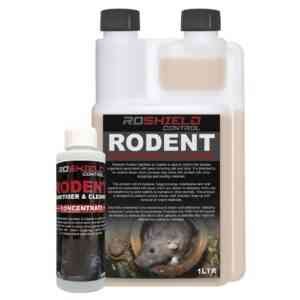
Roshield Rodent Sanitiser Concentrate
£10.24 – £16.74 inc. VAT View Product -

2 X Roshield Rodent Proofing Paste
£24.99 inc. VAT View Product -
Sale!

Roshield Stainless Steel Mesh Vent Cover
£15.99Original price was: £15.99.£14.99Current price is: £14.99. inc. VAT View Product -
Sale!

Roshield Metal Air Vent Cover
£24.99Original price was: £24.99.£22.99Current price is: £22.99. inc. VAT View Product

